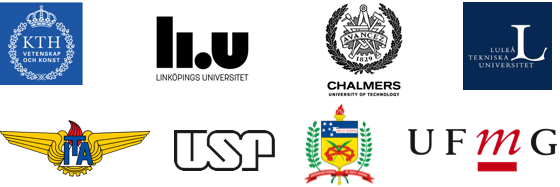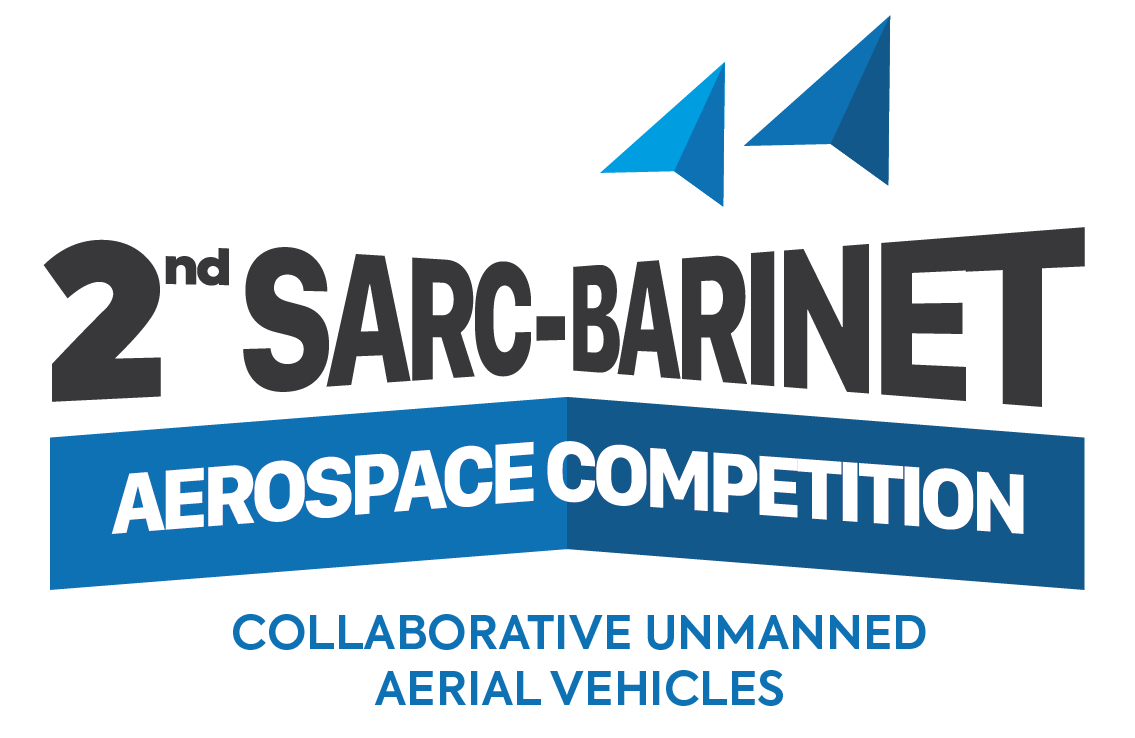Final result
After evaluation of the contributions submitted in the first phase, the following three teams were invited to submit their contribution for the second stage:
- Federal University of Santa Catarina: Bruno de Lima, Iago Silvestre, Pedro Henrique Dias, Jomi Hübner, Leandro Becker, Maiquel de Brito.
- Universidade Federal de Minas Gerais: Artur Costa, João Baião, Leonardo Santos, Sofia Paiva.
- University of São Paulo/SEMEAR: Lucas Cavalcanti, Guilherme Castro, Raul Cotrim Ferreira, Daniel Miguita, Matheus Martins, Guilherme Villela.
During the second session of the presentation, there were demonstrations from the teams but also from Brazilian companies working in the aerospace sector as well as research groups showing their work in the form of an exposition open to the general public.
Afterwards, the Jury in a closed section announced the USP-SEMEAR team (NoFire Squad Project) as the winner.
The swarm is able to search the terrain, find the region of fire, and initiate a strategy to slow down the spread of the flames. To understand the problem from the firefighters’ point of view, the Team met professionals from the Fire Department. The firefighting strategy was based on the way firefighters work. In this sense, one of the drones leads the others, helping them to position themselves to launch anti-fire substances in the regions surrounding the flames, thus preventing the fire from spreading quickly to regions not yet reached.
Background and scope
Systems of systems is an important field in modern aviation and a good example in this field is unmanned aerial vehicles used in collaboration to solve a specific task. With this competition the multi- disciplinary approach needed to develop technologies for such vehicles and their applications is encouraged and fostered. Awards for the best projects in this field will be granted with backing from industries in Sweden and Brazil.
The competition is about presenting the best solution to a selected problem involving multiple unmanned aircraft. This could be a few aircraft flying in formation or a swarm of smaller aircraft.
The competition encourages collaboration between academic disciplines as well as between academy and industry and is meant as an accelerator in the field of systems of systems research and, specifically, collaborative UAVs. It aims to motivate teamwork, facilitate innovation, expand international collaboration, foster entrepreneurship, and channel research into practical use. It is open to actors from Sweden and Brazil, but not necessarily only from organizations under the SARC-BARINet umbrella.
Theme
The theme of current version of competition is fire detection and fighting in forests using multiple UAVs. The requirement is that the UAVs should be dropped in the forest area by another aircraft.
Teams
The competition is open to anyone, except for employees of the Airspace Industry. Participants from startup companies are allowed and welcome.
Number of team members is limited to maximum 10 (Hard Limit – No exceptions).
Competition Format
The competition is design-oriented, i.e. the vehicle should be design. Teams may adapt and integrate commercial off-the-shelf parts, or entire aircraft, multicopters, etc. Design aspects includes mechanics, aerodynamics, flight controls, structures, electrical, electronical, software subsystems, and “systems of systems”. The inclusion of computer simulations in these different engineering areas are welcome.
The competition consists of two stages. Based on the outcome of the first stage, a selected number of groups from each country (Brazil and Sweden) will be invited to enter the second stage.
First stage
Drone design and manufacturing
Teams are allowed to modify a commercially available drone, although they are encouraged to design one in-house to optimize weight and payload mass
The teams will be scored based on the following criteria
- Ability to meet payload requirements of 1kg of fire-retardant liquid
- Ability to meet maximum take-off mass of 5kg including batteries
- Ability to meet the volume limitations of 0.5m3 (linear dimensions are non-restricted)
- Ability to meet the 20min endurance requirement
- Additional points will be given when exceeding these requirements
- In the case of the maximum take-off mass, this means a mass of less than 5kg, granted all other requirements are met
Mission for the simulated environment
The virtual environment (in ROS and GAZEBO environment) for the mission, alongside an existing drone model for the teams to familiarize themselves with the program can be found at https://github.com/2nd-sarc-barinet-aerospace-competition/sarc_environment
The mission is as stated below:
- Release of multiple drones (minimum 5) from the cargo door of a KC-390 (Hold length × height × width: 18.5×2.95×3.45 m (60.6×9.8×11.3 ft)) flying at a cruise velocity between 130 – 150 knots (CAS), and at an altitude of 800 – 1000 ft (above ground) above a forest-fire area of 10km x 10km.
- The release velocity of the drones from the cargo hold is of 85 m/s.
- The drones must carry 1kg minimum of fire-retardant liquid (density to be verified).
- The first requirement is for the drones to be activated and regroup as a formation once launched from the aircraft at the centre of the forest-fire area and hold position for 5 seconds.
- The drones then need to “interact” with the fire and deploy the fire retardant. The choice of the drones working as a storm to focus on a single area or as separate individuals is up to “mission control”. Where “mission control” is the team submitting the work.
- The drones then need to fly towards a pre-defined location outside of the fire area where they can be collected for future use.
The teams will be scored based on the following criteria:
- Complexity of the storms of drones
- Accuracy of positioning over a self-defined point over the fire area (for each individual drone if working independently or of the reference drone if working as a storm)
- Area of the fire covered
- Accuracy in relocating to defined post-mission rendezvous point
The top-3 teams from each country (Sweden and Brazil) will progress to the second phase of the competition: the live demonstration.
Second stage
Mission for the live demonstration
Teams are responsible for the meeting the cost of manufacturing and travel to the test site. The test site will be in Sweden for Swedish competitors, and Brazil for Brazilian competitors.
The teams will be scored based on the following requirements:
- Demonstrate autonomous flight capabilities and accuracy in hitting a target with payload drop.
- Take-off from a defined location and travel to a reference point
- Hold station for 15 secs at a set height
- Complete a mission with defined waypoints (one or more) and drop a payload at each waypoint in hover mode
- A copy of the drones used in the virtual environment simulation must e used for the live demonstration
- Score points will be assigned on:
- Accuracy of positioning at the way points and in hitting the target
- Time needed to complete the mission
Submission
Report should be prepared using the following template: SARC_Template
Contributions should be submitted through this page.
Timeline
The timeline is as follows:
- April 11th 2022: competition announcement
- July 1st 2022: submission of documents for Stage 1 (prolonged to July 22)
- July 13th 2022: announcement of teams progressing to Stage 2 (postpond to August 7)
- Week 41/Week 42: Live demonstration
- Exact date and location to be announced at the completion of Stage 1
- Date subject to change due to weather conditions
- November 7th 2022: Presentation of the awards at the CISB-SARC Congress
Awards
The winning team will receive flight tickets of a value of 6,000€ for team members, who will be invited to travel to Brazil (if they are Swedish) or Sweden (if Brazilian) and will meet with representatives of the country’s aerospace industry.
Competition contact
E-mail: aerospacecompetition@sarc.center
Q&A
Directors of competition
- Glauco Caurin (São Carlos School of Engineering, University of São Paulo)
- Raffaello Mariani (KTH Royal Institute of Technology)
Advisory board
- Magnus Ahlström (Vice President, Saab Global Innovation)
- Anders Blom (Director of the Swedish National Strategic Innovation Programme for Aeronautics, INNOVAIR)
- Brig. Roberto Follador (EMAER – Estado Maior da Aeronáutica)
- Björn Jonsson (Swedish Armed Forces Materiel Administration, FMV)
- Brig. Ricardo Mangrich (Ministry of Science, Technology, Innovations and Communications, MCTIC)
- Daniel Moczydlower (President & CEO, EmbraerX, Head of Innovation, Digital Transformation & New Business Development, Embraer S.A.)
- Mats Olofsson (INNOVAIR)
- Manuel Steidle (Centers of Reference in Innovative Technologies, CERTI)
Organizers

Supporting organisations


